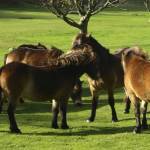Link Between Insulin and Laminitis in Horses Probed

Laminitis—the painful separation of laminae between the foot and hoof—occurs for many reasons. Examples include inflammation secondary to infection, carbohydrate overload, black walnut ingestion, and insulin dysregulation.
“Research shows that laminitis secondary to inflammation is distinct from other forms of laminitis, including endocrinopathic laminitis frequently seen in horses with equine metabolic syndrome,” explained Laura Petroski-Rose, B.V.M.S., a Kentucky Equine Research veterinarian.
Veterinarians have devised several hypotheses to explain the unique features associated with endocrinopathic laminitis. Some researchers believe high levels of insulin stimulate the growth of various cell types by activating insulin-like growth factor-1 (IGF-1). In turn, stimulation of IGF-1 receptors initiates a cascade of events that causes the abnormal growth of specific cells found in the lamella, contributing to the development of laminitis.
“This abnormal growth causes disorganized cells, potentially contributing to weak lamella,” Petroski-Rose shared.
A recent study confirmed the presence of IGF-1 receptors on lamellar cells. When exposed to insulin in cell cultures in the laboratory, those lamellar cells were stimulated to grow in a concentration-dependent manner.
“Administering an IGF-1 blocker significantly decreased the impact of insulin on lamellar cell growth,” relayed Petroski-Rose. “We know diet and exercise play important roles in the management of equine metabolic syndrome and insulin dysregulation. Contact a Kentucky Equine Research nutrition consultant for information on how best to approach your horse’s individual nutritional needs.”
In addition, consider some of the supplements available to help support hoof health. Kentucky Equine Research offers Bio-Bloom PS (Bio-Bloom HF in Australia), which contains a mixture of hoof-healthy minerals, such as biotin, methionine, iodine, and zinc.
*Baskerville, C.L., S. Chockalingham, P.A. Harris, et al. 2018. The effect of insulin on equine lamellar basal epithelial cells mediated by the insulin-like growth factor-1 receptor. Peer Journal. 6:e5945.








